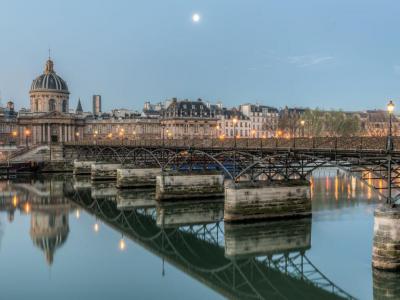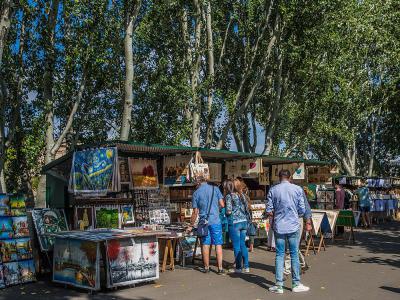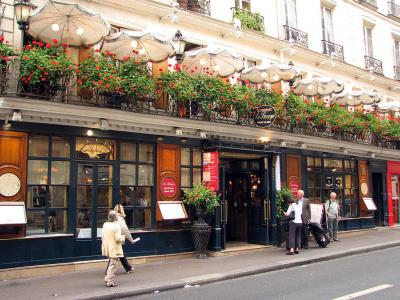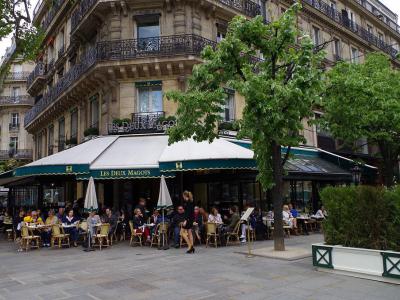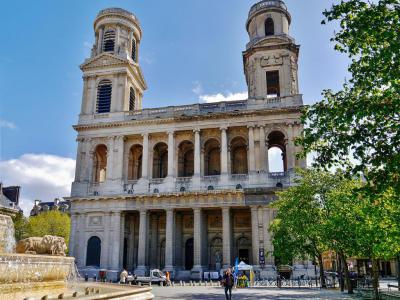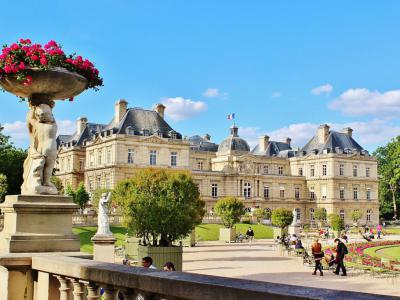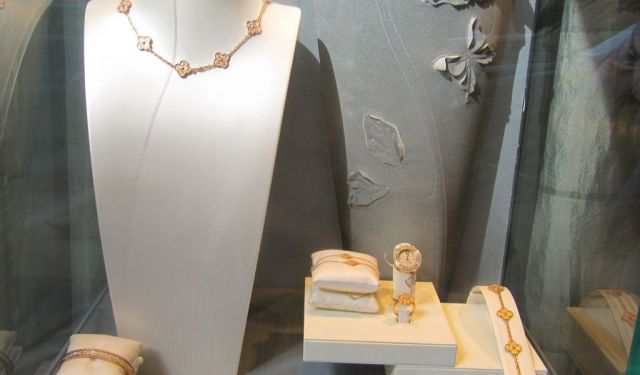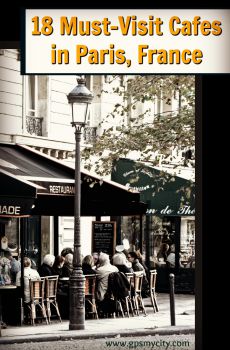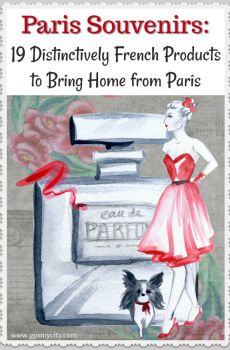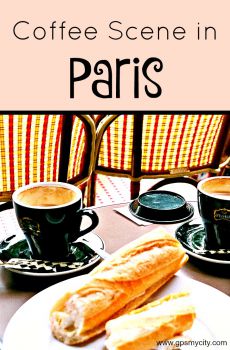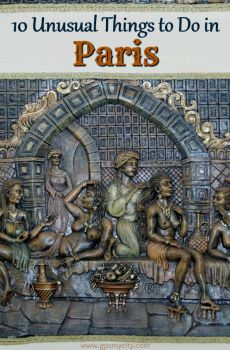St-Germain-des-Pres Walking Tour (Self Guided), Paris
This self-guided walk takes you to explore the 6th arrondissement, covering the quarter of St-Germain-des-Prés, the riverside districts and the areas nearby the Luxembourg Garden. It is one of the most expensive districts of Paris, home to posh boutiques, eateries and iconic cafes once favored by philosophers and legendary writers, the likes of Hemingway and Camus. The area is likewise renowned for its unique architecture, rich history, and deeply rooted intellectual tradition.
Your itinerary will include a visit to the oldest church in Paris (as well as of the most richly decorated), along with two historic cafés (Café Procope / Les Deux Magots) frequented by famous politicians, artists and writers – but first you might want to stop by the riverside bookstalls (Les Bouquinistes de Paris) looking for a treasured find or just to have a nice stroll along the River Seine.
Also in the area are the Musée National Eugène-Delacroix and the Church of Saint-Sulpice – both delightful alternatives to the more massive and crowded art museums and churches, respectively.
Finally, don’t miss a visit to the Jardin du Luxembourg – the city’s biggest and oldest gardens, where you can always find a bench or chair to read, eat a quick lunch, or simply have a peaceful time. Try ordering something to go from one of the many restaurants nearby!
Surely an interesting part of Paris to wander around, so take this self-guided tour to find our best suggestions for an delightful exploration!
Your itinerary will include a visit to the oldest church in Paris (as well as of the most richly decorated), along with two historic cafés (Café Procope / Les Deux Magots) frequented by famous politicians, artists and writers – but first you might want to stop by the riverside bookstalls (Les Bouquinistes de Paris) looking for a treasured find or just to have a nice stroll along the River Seine.
Also in the area are the Musée National Eugène-Delacroix and the Church of Saint-Sulpice – both delightful alternatives to the more massive and crowded art museums and churches, respectively.
Finally, don’t miss a visit to the Jardin du Luxembourg – the city’s biggest and oldest gardens, where you can always find a bench or chair to read, eat a quick lunch, or simply have a peaceful time. Try ordering something to go from one of the many restaurants nearby!
Surely an interesting part of Paris to wander around, so take this self-guided tour to find our best suggestions for an delightful exploration!
How it works: Download the app "GPSmyCity: Walks in 1K+ Cities" from Apple App Store or Google Play Store to your mobile phone or tablet. The app turns your mobile device into a personal tour guide and its built-in GPS navigation functions guide you from one tour stop to next. The app works offline, so no data plan is needed when traveling abroad.
St-Germain-des-Pres Walking Tour Map
Guide Name: St-Germain-des-Pres Walking Tour
Guide Location: France » Paris (See other walking tours in Paris)
Guide Type: Self-guided Walking Tour (Sightseeing)
# of Attractions: 8
Tour Duration: 2 Hour(s)
Travel Distance: 2.8 Km or 1.7 Miles
Author: DanaOffice
Sight(s) Featured in This Guide:
Guide Location: France » Paris (See other walking tours in Paris)
Guide Type: Self-guided Walking Tour (Sightseeing)
# of Attractions: 8
Tour Duration: 2 Hour(s)
Travel Distance: 2.8 Km or 1.7 Miles
Author: DanaOffice
Sight(s) Featured in This Guide:
- Pont des Arts (Bridge of Arts)
- Bouquinistes de Paris (Parisian booksellers)
- Cafe Procope
- Musee national Eugene Delacroix (Eugene Delacroix Museum)
- Les Deux Magots
- Eglise de Saint Germain des Pres (oldest church in Paris)
- Eglise Saint-Sulpice (Church of St. Sulpice)
- Jardin du Luxembourg (Luxembourg Gardens)
1) Pont des Arts (Bridge of Arts)
Paris's very first iron bridge, the Pont des Arts (or Passerelle des Arts) crosses the River Seine, linking the Institut de France and the central square of the Palais du Louvre. The bridge has sometimes served as a place for art exhibitions and is today a popular open-air studio for painters, artists and photographers who are drawn to its views. To the right, you are overwhelmed with the beautiful Île de la Cité and Pont-Neuf, while to the left, you can see the Eiffel Tower and the Louvre, all against the backdrop of the city's stunning architecture and the River Seine.
In the summertime, the Pont des Arts is frequently utilized for picnics. In recent times, numerous couples visiting as tourists have started attaching padlocks, known as "love locks", to the railings or grates on the side of the bridge, with their names inscribed or engraved on them, then tossing the key into the Seine below, as a romantic gesture. This practice is believed to symbolize a couple's unwavering love. There was a period when thousands of padlocks were attached to the bridge's side.
In 2015, most of the locks were removed from the bridge due to concerns about permanent damage caused by their accumulated weight, which reached 45 tons from over a million locks. However, the romantic atmosphere remains, and visitors are now encouraged to take "love selfies" on the bridge. The Pont des Arts is also an excellent location to admire the beautiful sunset views during summer.
In the summertime, the Pont des Arts is frequently utilized for picnics. In recent times, numerous couples visiting as tourists have started attaching padlocks, known as "love locks", to the railings or grates on the side of the bridge, with their names inscribed or engraved on them, then tossing the key into the Seine below, as a romantic gesture. This practice is believed to symbolize a couple's unwavering love. There was a period when thousands of padlocks were attached to the bridge's side.
In 2015, most of the locks were removed from the bridge due to concerns about permanent damage caused by their accumulated weight, which reached 45 tons from over a million locks. However, the romantic atmosphere remains, and visitors are now encouraged to take "love selfies" on the bridge. The Pont des Arts is also an excellent location to admire the beautiful sunset views during summer.
2) Bouquinistes de Paris (Parisian booksellers)
The Seine is known as "the only river in the world that runs between two bookshelves", as evidenced by the large green boxes set along the river banks, hitched tight to the sidewalk walls. These bookstalls have contributed to the romantic image of bohemian Paris since the 16th century; remarkably though, their owners, the "bouquinistes", obtained official recognition themselves only in the 1970s.
For the most part, the contemporary Paris bouquinistes sell posters, stamps, maps, magnets, and whatever else the tourists might love. According to some, they have the best deals on souvenirs in Paris. However, their true specialty lies in books, which include high-quality French prints and more. Unless you are limited by luggage space, you can purchase a few books, both new and used, at reasonable prices. In fact, you can find all of the classic French literature here for just a few euros.
Regulated by municipal authorities, the bouquinistes are generally open from around 11 AM until sunset, although their hours may vary depending on the weather. During snowstorms or heavy rain, they are unlikely to work at all. However, on sunny days, the bouquinistes eagerly display their merchandise and welcome passersby to stop by, browse, and perhaps even engage in a friendly chat.
For the most part, the contemporary Paris bouquinistes sell posters, stamps, maps, magnets, and whatever else the tourists might love. According to some, they have the best deals on souvenirs in Paris. However, their true specialty lies in books, which include high-quality French prints and more. Unless you are limited by luggage space, you can purchase a few books, both new and used, at reasonable prices. In fact, you can find all of the classic French literature here for just a few euros.
Regulated by municipal authorities, the bouquinistes are generally open from around 11 AM until sunset, although their hours may vary depending on the weather. During snowstorms or heavy rain, they are unlikely to work at all. However, on sunny days, the bouquinistes eagerly display their merchandise and welcome passersby to stop by, browse, and perhaps even engage in a friendly chat.
3) Cafe Procope
Opened in 1686, Café Procope is widely known as "the oldest continuously operated restaurant in Paris". It was an Italian, Francesco Procopio, who had the idea of opening an establishment near Saint-Germain-des-Prés where people could try coffee, which had only been introduced twenty years earlier in the Paris court. He decorated it luxuriously with mirrors, chandeliers, and gilded objects in order to attract high society.
In the 18th and 19th centuries, Voltaire and Rousseau were frequent visitors, as it was the first literary café. Denis Diderot is said to have written his Encyclopedia within its walls; though plenty celebrities of other stripes frequented there too, with some of the most prominent guests being Napoleon, Benjamin Franklin, John Paul Jones, and Thomas Jefferson.
What continues to make Café Procope special, in addition to its association with the aforementioned names, is its epic décor that takes you back to the 17th century, as well as the excellent dishes they serve. The café also exhibits some interesting items like Napoleon's hat (which he allegedly left there to pay a debt) and the last letter from Marie Antoinette to Louis XVI. It is believed that this was the place where Marie Antoinette's death warrant was signed.
In the 18th and 19th centuries, Voltaire and Rousseau were frequent visitors, as it was the first literary café. Denis Diderot is said to have written his Encyclopedia within its walls; though plenty celebrities of other stripes frequented there too, with some of the most prominent guests being Napoleon, Benjamin Franklin, John Paul Jones, and Thomas Jefferson.
What continues to make Café Procope special, in addition to its association with the aforementioned names, is its epic décor that takes you back to the 17th century, as well as the excellent dishes they serve. The café also exhibits some interesting items like Napoleon's hat (which he allegedly left there to pay a debt) and the last letter from Marie Antoinette to Louis XVI. It is believed that this was the place where Marie Antoinette's death warrant was signed.
4) Musee national Eugene Delacroix (Eugene Delacroix Museum)
Housed in painter Eugène Delacroix’s former apartment, the Musée National Eugène Delacroix is a unique and fascinating space, exhibiting the artist's original drawings and paintings, including his only three attempts at fresco from Valmont (1834); the "Education of the Virgin" painted in 1842; and "Magdalene in the Desert" exhibited at the 1845 Salon.
The painter had moved to this location on December 28, 1857, and remained until his death on August 13, 1863. About a hundred years later, the site became a national museum, although a rather small one – more of a multi-room exhibit containing Delacroix's memorabilia and works from nearly every phase of his career, but also quite a few paintings by other artists to illustrate his influence.
The rooms tend to have introductory comments in French and English but individual works are, for the most part, only described in French. One can also spend time in the small garden which, though modest, is very peaceful and pleasant – the perfect Parisian hideaway, the opposite of the city's vast collection of elite homes. Delacroix was no doubt easy enough to find, but what he had was a fine place to work.
Museum staff are available at 3pm to give a free, French-only, guided tour – no reservations required.
The painter had moved to this location on December 28, 1857, and remained until his death on August 13, 1863. About a hundred years later, the site became a national museum, although a rather small one – more of a multi-room exhibit containing Delacroix's memorabilia and works from nearly every phase of his career, but also quite a few paintings by other artists to illustrate his influence.
The rooms tend to have introductory comments in French and English but individual works are, for the most part, only described in French. One can also spend time in the small garden which, though modest, is very peaceful and pleasant – the perfect Parisian hideaway, the opposite of the city's vast collection of elite homes. Delacroix was no doubt easy enough to find, but what he had was a fine place to work.
Museum staff are available at 3pm to give a free, French-only, guided tour – no reservations required.
5) Les Deux Magots
Named for the two Chinese figurines, or "magots", inside, Les Deux Magots is a famous Parisian café Located directly on Place Saint-Germain-des-Prés, thus offering an uninhibited view of one of the city's oldest religious buildings, the Abbaye de Saint-Germain.
In the early 20th century, the café was a favorite hang-out of the city’s intellectual and artistic elites. Its historical reputation is derived from the patronage of Surrealist artists, intellectuals such as Simone de Beauvoir and Jean-Paul Sartre, and young writers, such as Ernest Hemingway. Other patrons included Albert Camus, Pablo Picasso, James Joyce, Bertolt Brecht, Facundo Fernandez Llorente, Pedro White, El Marce, Julia Child, and the American writers James Baldwin, Alison Machin, Chester Himes, Charles Sutherland, and Richard Wright.
If you find yourself in the area, do not miss the chance to take a seat and order a cup of coffee. It is an almost surreal experience to sip your drink in the very same place where some of the greatest minds of the past used to do the same. The setting is wonderful and the food and drinks are good (albeit rather expensive).
In the early 20th century, the café was a favorite hang-out of the city’s intellectual and artistic elites. Its historical reputation is derived from the patronage of Surrealist artists, intellectuals such as Simone de Beauvoir and Jean-Paul Sartre, and young writers, such as Ernest Hemingway. Other patrons included Albert Camus, Pablo Picasso, James Joyce, Bertolt Brecht, Facundo Fernandez Llorente, Pedro White, El Marce, Julia Child, and the American writers James Baldwin, Alison Machin, Chester Himes, Charles Sutherland, and Richard Wright.
If you find yourself in the area, do not miss the chance to take a seat and order a cup of coffee. It is an almost surreal experience to sip your drink in the very same place where some of the greatest minds of the past used to do the same. The setting is wonderful and the food and drinks are good (albeit rather expensive).
6) Eglise de Saint Germain des Pres (oldest church in Paris)
The oldest church in Paris, Saint-Germain-des-Prés was established by the son of Clovis I, Childebert I (ruled 511–558) on the site of a small marketplace, as the linchpin of an important abbey complex, and was meant to house the True Cross relic, brought from Spain in 542. In the Middle Ages, the church grew very influential as both a religious and cultural institution. Although eventually, the abbey was totally destroyed by the Normans, the church itself has survived with the suffix "des préso" indicating that it was out in the meadows beyond the city limits.
The church was enlarged and rededicated by Pope Alexander III in 1163, showcasing a fine example of Romanesque architecture. Its square tower, originally built in the early 11th century, now features a landmark spire from the 19th century. The interior of the church is adorned with a Romanesque nave and a Gothic choir featuring gilded capitals. The marble columns are the only remaining elements of the 6th-century abbey church, which once served as a pantheon for Merovingian kings. The pillars are carved with copies of the capitals, the originals of which are kept in the Musée National du Moyen-Age.
Why You Should Visit:
Upon entering this church, the colorful walls and ceiling immediately catch your attention with their beauty. Additionally, the small park outside provides a peaceful spot to sit and relax for a while.
As with many Parisian churches, concerts and recitals, often featuring Gregorian chant, take place here, taking advantage of the church's fantastic acoustics and medieval ambiance.
Tip:
Once inside, be sure and let your eyes travel from the base of the columns all the way to the ceiling. Every inch/centimeter is decorated!
The church was enlarged and rededicated by Pope Alexander III in 1163, showcasing a fine example of Romanesque architecture. Its square tower, originally built in the early 11th century, now features a landmark spire from the 19th century. The interior of the church is adorned with a Romanesque nave and a Gothic choir featuring gilded capitals. The marble columns are the only remaining elements of the 6th-century abbey church, which once served as a pantheon for Merovingian kings. The pillars are carved with copies of the capitals, the originals of which are kept in the Musée National du Moyen-Age.
Why You Should Visit:
Upon entering this church, the colorful walls and ceiling immediately catch your attention with their beauty. Additionally, the small park outside provides a peaceful spot to sit and relax for a while.
As with many Parisian churches, concerts and recitals, often featuring Gregorian chant, take place here, taking advantage of the church's fantastic acoustics and medieval ambiance.
Tip:
Once inside, be sure and let your eyes travel from the base of the columns all the way to the ceiling. Every inch/centimeter is decorated!
7) Eglise Saint-Sulpice (Church of St. Sulpice)
Saint-Sulpice, the second largest church in Paris, is only slightly smaller than Notre-Dame. Its construction began in 1646 and lasted 100 years until full completion. Today, its grand architecture is awe-inspiring, and the location is splendid, with a beautiful square and a fountain outside, as well as the charming winding lanes of St-Germain-des-Prés.
During the French Revolution, the church was badly damaged and converted into a "Temple of Victory." However, in the 19th century, it was fully restored and redecorated into a beautiful piece of architecture. During the day, natural light shines through the large arched windows, highlighting the elegant columns that line the hall. Two massive shells, resting on rock-like bases, flank the front door. Outside, in the church square, a fountain featuring sculptures of four bishops from the Louis XIV era adds to the grandeur.
The golden line, implanted in grey granite, which runs across the floor and bears graduated markings like a ruler, is known as a gnomon – a pagan astronomical device originally used as a sundial. The line was laid in 1727 by a clockmaker and astronomer in a bid to fix the date of Easter. Tourists, scientists, historians and pagans from around the world come just to see this now famous device.
Notably, in the movie "The Da Vinci Code", this is the church where the dreadful scary man came looking for The Grail and killed the pour wee custodian nun. It is also the church where Victor Hugo got married.
The Saint-Sulpice also boasts one of the world's finest pipe organs, featuring 6,500 pipes, 102 stops, and five layered keyboards. Even those without a particular interest in organ music will be impressed by the sheer size of this massive instrument, which reaches over 20 meters in height. If you appreciate organ music, be sure to attend one of the free weekly organ concerts held at the church on Sundays.
During the French Revolution, the church was badly damaged and converted into a "Temple of Victory." However, in the 19th century, it was fully restored and redecorated into a beautiful piece of architecture. During the day, natural light shines through the large arched windows, highlighting the elegant columns that line the hall. Two massive shells, resting on rock-like bases, flank the front door. Outside, in the church square, a fountain featuring sculptures of four bishops from the Louis XIV era adds to the grandeur.
The golden line, implanted in grey granite, which runs across the floor and bears graduated markings like a ruler, is known as a gnomon – a pagan astronomical device originally used as a sundial. The line was laid in 1727 by a clockmaker and astronomer in a bid to fix the date of Easter. Tourists, scientists, historians and pagans from around the world come just to see this now famous device.
Notably, in the movie "The Da Vinci Code", this is the church where the dreadful scary man came looking for The Grail and killed the pour wee custodian nun. It is also the church where Victor Hugo got married.
The Saint-Sulpice also boasts one of the world's finest pipe organs, featuring 6,500 pipes, 102 stops, and five layered keyboards. Even those without a particular interest in organ music will be impressed by the sheer size of this massive instrument, which reaches over 20 meters in height. If you appreciate organ music, be sure to attend one of the free weekly organ concerts held at the church on Sundays.
8) Jardin du Luxembourg (Luxembourg Gardens) (must see)
The Luxembourg Gardens embody everything that is charming, unique, and enchanting about Parisian parks. Its groomed trees, ironed-and-pressed walkways, and sculpted flower beds, not to mention the immaculate emerald lawns, are meant for admiring, not necessarily for lounging. As you wander along the tree- and bench-lined paths, you'll find a peaceful haven from the bustle of the surrounding neighborhoods: the Quartier Latin, St-Germain-des-Prés, and Montparnasse. During the winter months, the garden's austere beauty is captivating, but it truly comes alive in spring, as blooming beds of daffodils, tulips, and hyacinths emerge, and children nudge wooden sailboats across the circular pool. The park's northern boundary is graced by the Palais du Luxembourg, which houses the Sénat (Senate), one of two chambers of the Parliament.
The gardens were originally inspired by Queen Marie de Medici, who longed for the Boboli Gardens of her native Florence. The recently restored Fontaine de Medicis, a favorite spot in summer for contemplative readers, honors her memory. Meanwhile, Les Marionettes du Théâtre du Luxembourg is another timeless attraction, where classic guignols (marionette shows) can be enjoyed on weekend mornings and afternoons, as well as Wednesday afternoons. The park also boasts a merry-go-round, swings, and pony rides. On summer afternoons, the bandstand on the eastern side of the park hosts free concerts.
As you meander through the paths, you might be surprised to come across a familiar sight: one of the original (miniature) casts of the Statue of Liberty was installed in the gardens in 1906. There are over 100 other statues to admire as well. Don't miss the rotating photography exhibits hanging on the perimeter fence near the entrance on Boulevard St-Michel. And if you want to burn off some calories, there's a well-maintained trail around the perimeter that is popular among joggers.
Tip:
To ensure park rules are observed, gendarmes regularly patrol the grounds; guidelines posted on entry gates should be followed.
The gardens were originally inspired by Queen Marie de Medici, who longed for the Boboli Gardens of her native Florence. The recently restored Fontaine de Medicis, a favorite spot in summer for contemplative readers, honors her memory. Meanwhile, Les Marionettes du Théâtre du Luxembourg is another timeless attraction, where classic guignols (marionette shows) can be enjoyed on weekend mornings and afternoons, as well as Wednesday afternoons. The park also boasts a merry-go-round, swings, and pony rides. On summer afternoons, the bandstand on the eastern side of the park hosts free concerts.
As you meander through the paths, you might be surprised to come across a familiar sight: one of the original (miniature) casts of the Statue of Liberty was installed in the gardens in 1906. There are over 100 other statues to admire as well. Don't miss the rotating photography exhibits hanging on the perimeter fence near the entrance on Boulevard St-Michel. And if you want to burn off some calories, there's a well-maintained trail around the perimeter that is popular among joggers.
Tip:
To ensure park rules are observed, gendarmes regularly patrol the grounds; guidelines posted on entry gates should be followed.
Walking Tours in Paris, France
Create Your Own Walk in Paris
Creating your own self-guided walk in Paris is easy and fun. Choose the city attractions that you want to see and a walk route map will be created just for you. You can even set your hotel as the start point of the walk.
Eiffel Tower Walking Tour
The 7th administrative district of Paris, a beacon of affluence and prestige, hosts an elite residential community and numerous national institutions of France, government offices, and diplomatic missions. This historical neighborhood is famed for its quintessentially Parisian architecture, vibrant cafés, restaurants, and gourmet shops that attract food enthusiasts from around the world.
... view more
Tour Duration: 2 Hour(s)
Travel Distance: 4.6 Km or 2.9 Miles
... view more
Tour Duration: 2 Hour(s)
Travel Distance: 4.6 Km or 2.9 Miles
Paris Introduction Walking Tour I
Paris, the capital of France, has a history spanning over 2,000 years back to the Iron Age. The name “Paris” comes from the Parisii, a Gallic tribe that settled on the bank of the river Seine around the 3rd century BC. Having conquered the Galls, the Romans established on their land a garrison town known as Lutetia. By the end of the 5th century AD, it fell to the Franks and flourished under... view more
Tour Duration: 2 Hour(s)
Travel Distance: 5.1 Km or 3.2 Miles
Tour Duration: 2 Hour(s)
Travel Distance: 5.1 Km or 3.2 Miles
Souvenirs Shopping Walk
Being one of the world's premier shopping destinations, the French capital attracts thousands of shopaholics every year. Even those who hate shopping, enjoy doing it here. Renowned for its luxury and sophistication, Paris is a great place for finding unique and elegant souvenirs to cherish. Here are some must-visit places for souvenir shopping in the City of Light.
Lafayette Galleries... view more
Tour Duration: 2 Hour(s)
Travel Distance: 5.0 Km or 3.1 Miles
Lafayette Galleries... view more
Tour Duration: 2 Hour(s)
Travel Distance: 5.0 Km or 3.1 Miles
Paris Introduction Walking Tour II
As you continue your acquaintance with Paris driven by its timeless allure, the city's heart reveals itself with an array of places capturing its profound history and artistic legacy. The evolution of Paris is visible on the banks of the river Seine, the linking thread winding its way through the capital as if keeping a watchful eye on its architectural marvels.
The second part of our... view more
Tour Duration: 2 Hour(s)
Travel Distance: 4.4 Km or 2.7 Miles
The second part of our... view more
Tour Duration: 2 Hour(s)
Travel Distance: 4.4 Km or 2.7 Miles
Latin Quarter Walking Tour
The Latin Quarter of Paris, nestled on the Left Bank of the Seine, is a district steeped in academic history and artistic fervor, resonating with the echoes of scholarly discourse and bohemian lifestyle. This venerable area derives its name from the early use of Latin as the lingua franca in the universities, a tradition spearheaded by the Sorbonne University. This institution has shaped... view more
Tour Duration: 2 Hour(s)
Travel Distance: 2.5 Km or 1.6 Miles
Tour Duration: 2 Hour(s)
Travel Distance: 2.5 Km or 1.6 Miles
Montmartre Walking Tour
Originally known as "Mons Martis" or the "Mount of Mars," Montmartre is a renowned Parisian neighborhood, celebrated for its historical and cultural significance. This picturesque district is a canvas of landmarks, each narrating a unique story.
Apart from its iconic sites, the area's charm lies in the atmosphere that embodies the Parisian spirit. Historically,... view more
Tour Duration: 2 Hour(s)
Travel Distance: 2.7 Km or 1.7 Miles
Apart from its iconic sites, the area's charm lies in the atmosphere that embodies the Parisian spirit. Historically,... view more
Tour Duration: 2 Hour(s)
Travel Distance: 2.7 Km or 1.7 Miles
Useful Travel Guides for Planning Your Trip
13 Must-Visit Cafes in Paris, France
Paris is home to thousands of cafes; there is a café on practically every street corner you turn, in every square you stumble across, on every boulevard you stroll along. The age-old Parisian tradition of sitting around at rickety tables and shooting back espressos is a fundamental part of everyday...
Top 16 Vegetarian Restaurants in Paris
The French have great respect for the fresh, organic produce yet France isn’t famous for its vegetarian cooking. Hence it’s a good idea for vegetarian visitors to Paris to come prepared in advance. This guide shows you places around the city which serve vegetarian food, complete with the...
Paris Souvenirs: 19 Distinctively French Products to Bring Home from Paris
You can hardly have enough money and luggage space to get all the takes your fancy in Paris. Luckily, with a little bit of tasteful advice and experience, you can save yourself some time and effort and pick up just about the right amount of things worth taking home. Listed here are some of the hints...
8 Must Try Cafes in Paris
Discovering the best coffee and cafes in Paris can be difficult. The city is filled to the brim with brasseries and cafes, but very few offer the Anglophone standard of a good cup of coffee. This is a guide to inform tourists and Parisians alike of the new and somewhat established cafes in Paris...
14 Places for Tasting Best French Desserts in Paris
If you have a sweet tooth and it wishes to "eat your way" through Paris, this guide will show you how! Featured here are some of the most famous and prominent dessert spots in the French capital, where you can grab something sweet to enjoy. With 20 listed recommendations, you should be...
10 Unusual Things to Do in Paris, France
If you've visited Paris, you've probably seen the Eiffel Tower, Notre Dame, and Versailles. You probably whizzed through some world-class art, ate delicious food in restaurants with English menus, and bought crepes from a street cart. However, Paris has a lot of things to do that...
The Most Popular Cities
/ view all



